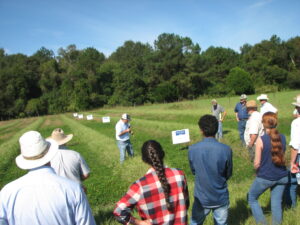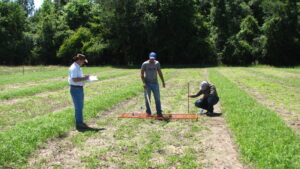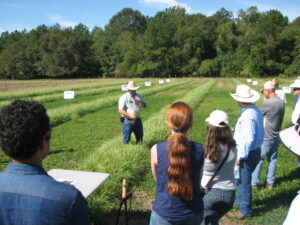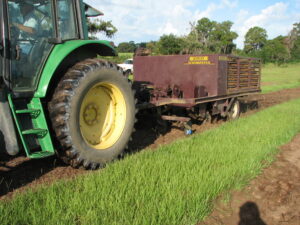Final Report for OS13-078
Project Information
This project tested novel approaches to establish rhizoma peanut (Arachis glabrata Benth) on bahiagrass (Paspalum notatum Flugge) pastures. We selected four producers in strategic locations of Florida Panhandle, North-Central Florida, and South Florida. The producers and their respective locations were: 1) Mr. Mack Glass, Marianna, FL; 2) Mr. Larry Rooks, Inverness, FL; 3) Dr. Michael Fields, Bushnell, FL; and 4) Mr. Glen Emerson, Wauchula, FL. Using a participatory approach and based on our research objectives, we established four on-farm trials, one at each farm. We tested two rhizoma peanut cultivars (Florigraze and Ecoturf) using different establishment methods (no-till and prepared soil). Rhizoma peanut was strip-planted into bahiagrass pastures. In each on-farm trial, treatments were replicated four times. Plots were established in June 2014 in all four participant farms. After establishment, six evaluations were performed from June 2014 to November 2015, using indirect measurements to measure rhizoma peanut establishment and soil cover. In 2015, we collected yield data and measured N2-fixation by the rhizoma peanut.
We hosted a field day at Mack Glass location in Marianna in October 2015 and had 45 participants. We also presented our results in the Perennial Peanut Field Day at the NFREC in Marianna in June 2015 and at the Beef and Forage Field Day at NFREC in April 2016. In addition, we strip-planted perennial peanut at the Silver Spurs Ranch, Kenansville, FL, owned by the Florida Cattlemen Association. Our results indicated that Ecoturf planted on prepared seedbed established faster and presented better results than Florigraze. Strip-planting perennial peanut allows reduction of N fertilization because of biological N2-fixation. Several extension publications were released in outlets such as Florida Cattlemen Magazine, Panhandle Ag e-news, Hay and Forage Growers, and SE Cattle Advisor, demonstrating the benefits of strip-planting perennial peanut. Recently our group was granted a USDA award and we are assessing the strip-planted perennial peanut on a grazing trial in Marianna, FL. The SARE grant allowed our group to demonstrate the technique for producers. Although the grant finished, we are still planning to have a field day at the southernmost location in Wauchula, FL.
 Field day at Mr. Mack Glass farm demonstrating the strip-planting of perennial peanut to producers
Field day at Mr. Mack Glass farm demonstrating the strip-planting of perennial peanut to producers
Introduction
Nitrogen (N) is one of the most important inputs in agricultural production systems. It is an essential element required for plant and animal growth and it is usually limiting due to low soil organic matter, particularly in sandy soils like those found throughout Florida and the Gulf Coast Region. Nitrogen is abundant in the atmosphere, but it must be reduced to be plant available. The process of industrial N reduction to produce fertilizer requires fossil fuel energy. In addition, N fertilizer application increases emissions of N2O and NO, two important greenhouse gases (Bouwman et al., 2002). As a result, N fertilizers have one of the largest carbon footprints of all farm inputs. Lal (2004) indicated that carbon emissions due to production, transportation, storage, and distribution of N fertilizer range from 3.3-6.6 kg CO2 equivalent per kg N. Current N fertilizer use in Florida forage production ranges from 60 to 150 kg N per ha annually depending on the intensification of the system. This accounts for the emission of 198-990 kg CO2 equivalent per ha from the N fertilizer alone. In addition, if not adequately managed, N fertilizers may contaminate the ground water when applied to soils prone to leaching, like those present in Florida. Lastly, prices of N fertilizer have increased dramatically in recent years, and this trend is expected to continue.
Within this context of growing challenges and problems associated with the use of N fertilizer, warm-season perennial grass pastures receiving N fertilizer remain the foundation of the cow-calf system in the Southeast USA. As N costs rise, producers face an increasingly grim outlook in which economic realities limit or preclude use of N fertilizer. Because grass pastures are nearly always N limited, this results in lower forage production and in some cases degradation of the grassland resource. Degraded grasslands provide inadequate feed for livestock and reduced economic return and ecosystem services. With 32% of regional land area in pasture and a 12.8 million beef cow census, achieving sustainable grassland agroecosystems is of great significance for the Southeast USA.
Rhizoma peanut (Arachis glabrata Benth.) is a long-lived perennial legume that has potential to associate with warm-season perennial grasses in SE USA. Rhizoma peanut establishment, however, is expensive. This has limited its use for grazing by the large beef cattle herd in the region. Because it can spread in bahiagrass and bermudagrass pastures and has been shown to live for more than 30 years, overcoming the barrier of establishment cost is critical to development of sustainable pasture systems that do not require N fertilizer. Thus, there is a current need to evaluate technologies that: i) reduce the cost of rhizoma peanut establishment; ii) minimize the period of time during establishment that land is taken out of the grazing program, and iii) result in low-input and sustainable grazing systems for beef cattle in the region. Developing on-farm technology that addresses these aspects will facilitate rhizoma peanut establishment by producers, accelerate technology transfer, and increase sustainability of grazing systems in SE USA.
Nitrogen fertilizer use may be reduced if it can be replaced by N-fixing legumes. These plants are able to fix N2 from the atmosphere through a symbiosis with microorganisms. This biological N fixation (BNF) may increase sustainability of grazing systems by reducing production costs, reducing carbon footprint from farming operations, and reducing the risk of ground water contamination. Among different legume options, rhizoma peanut is one of the best for the southern Gulf Coast region. It is a perennial legume that persists well under grazing and it is also well suited for use as a hay crop. Establishment of rhizoma peanut, however, is slow and expensive, and as a result the crop has been used almost exclusively as high value hay for equine or dairy systems. Greater use in grazed pastures for beef cattle is needed in order to address the N limitations of these systems without relying on fertilizer N. Recent research findings of our team (Castillo et al., 2013a and 2013b) suggest that strip-planting rhizoma peanut in existing perennial warm-season grass pasture is a viable option to reduce establishment cost. These studies also identified the importance of weed control and defoliation management in order to enhance establishment. It was determined that producers would be able to utilize the area for hay harvest during the establishment year, with grazing occurring in subsequent years. These results have been demonstrated and discussed at producer field days in 2012 and 2013. Interaction with producers in these settings and on their farms has revealed that they are interested in adopting this approach to rhizoma peanut establishment and fine-tuning it on their farms.
Our general objective was to find fast and cost-effective ways to establish rhizoma peanut onto existing bahiagrass pastures, reducing the use of synthetic N fertilizer and improving overall forage quality. We tried different approaches. The strip-planting reduces establishment cost because of reduced planted area. Prepared seedbed was the best establishment and Ecoturf the best variety, in all locations. Our target audience are beef producers who have their livestock operation based on pastures, which are the majority of Florida livestock producers. We had one on-farm field day, two field days at the Research Station (NFREC in Marianna), and we also strip-planted perennial peanut at the Silver Spurs Ranch, owned by the Florida Cattlemen Association, where we also hosted a field day in Nov. 2015. Educational materials were prepared and released in different outlets, helping us to get to our target audience.
Cooperators
Research
We established four on-farm trials to assess the strip-planting of two cultivars of perennial peanut (Ecoturf and Florigraze) and two establishment methods (prepared seedbed and no-till planting). Treatments were allocated in a split-plot arrangement of a randomized block design with four replicates on each farm. Planting method was the main plot and RP cultivar the subplot. Main plot measured 12 x 18 m and subplot 12 x 6 m. All plots were established on existing bahiagrass stand and the grass present on the strips were killed with glyphosate (6.2 kg a.i. ha-1). Prepared seedbed treatment was accomplished by deep tillage od glyphosate killed strips with a moldboard plow and heavy disking in spring; the no-till planting was accomplished by spraying the strip with glyphosate followed by spring mowing of remaining above-ground biomass to 5-cm stubble height before no-till planting of perennial peanut. Perennial peanut strips were 2 m wide and were separated by grass trips with similar width. Soil samples were taken prior the establishment of the experiment and fertilization followed IFAS recommendation. Weed control on RP strips was accomplished by applying imazapic {imazapic; (+/- -2-[4,5-dihydro-4-methyl-4-(1-methylethyl)-5-oxo-1 H-imidazol-2-yl]-5-methyl-3-pyridinecarboxylicacid; Impose} at a rate of 0.07 kg a.i. ha-1 when grass or broadleaf weeds were 5- to 10-cm tall. During the establishment year, the grass strips was mowed every 5 weeks simulating a hay/haylage field operation. Response variables included canopy cover and frequency of RP, rate of spread of RP, herbage accumulation, and plant tissue analyzes to measure total N concentration, DM, OM, and 15N. Herbage mass was determined by sampling two 0.5-m2 quadrats (1 x 0.5 m) on each subplot. Natural abundance technique was used to determine the percentage of N derived from the atmosphere (%Ndfa). Statistical analyses were performed using proc mixed from SAS. Least squared means were compared using the PDIFF procedure adjusted by Tukey at 5% probability level.
Marianna, FL
Perennial peanut cultivars differed (P < 0.05) on the rate of establishment, with Ecoturf promoting a greater cover (95%) compared to Florigraze (81%). Perennial peanut height also differed, with greater average plant height observed for Ecoturf (7.2 cm) compared to Florigraze (6.3). Despite differences in cover and plant height, above-ground biomass was similar between cultivars and methods. Ecoturf herbage mass in October 2015 was 1570 kg DM/ha and Florigraze was 1495 kg DM/ha. No-till and prepared seedbed were similar (1530 vs. 1533 kg DM/ha) compared across cultivars. From June 2015 to October 2015, average herbage mass went from 740 to 2320 kg DM/ha, demonstrating the rapid growth upon establishment. Average crude protein concentration was 18.75% for Ecoturf and 17.5% for Florigraze. We will continue monitoring the plots, even without the funding in order to have a second year of data on the biomass yield.
 Assessment of soil cover and perennial peanut spread; May 2015
Assessment of soil cover and perennial peanut spread; May 2015  Fully established perennial peanut strips in Marianna, FL. Oct. 2015
Fully established perennial peanut strips in Marianna, FL. Oct. 2015
Inverness, FL
Ecoturf presented soil cover (in Oct 2015) of 17% and Florigraze 11%. These results were not statistically different (P > 0.05). These results reflect the site differences between Marianna and Inverness in Florida. Reasons for these differences might be related to soil and environmental conditions. Perennial peanut often presents slow establishment process because it is building rhizome mass below ground. Ecoturf presented 750 kg DM per ha in Oct. 2015 and Florigraze 350 kg DM/ha. These results were not significantly different (P = 0.13). Establishment methods were also similar (P = 0.19), with prepared seedbed resulting in 655 kg DM/ha and no-till in 440 kg DM/ha. Average perennial peanut crude protein concentration was 12.7%.
 Strip-planting of perennial peanut in Inverness, FL
Strip-planting of perennial peanut in Inverness, FL
Wauchula, FL
Plots in Wauchula had similar results observed in the other locations. Perennial peanut had a slower establishment and weed competition was a problem, specially in the first season. Plots were harvested in Oct.2014, June and Oct. 2015. In Oct. 2014, Ecoturf above-ground biomass was 750 kg DM/ha versus 346 kg DM/ha observed for Florigraze, however, differences were not significant (P = 0.13). In the same harvest, the average across cultivars for establishment method was 440 kg DM/ha for no-till planting and 655 kg DM/ha for prepared seedbed. Average crude protein observed was 12%. In 2015, total herbage mass (sum of June and Oct. 2015) was significantly greater for Ecoturf (1752 kg DM/ha) than Florigraze (1215 kg DM/ha). Prepared seedbed resulted in greater herbage mass (1807 kg DM/ha) compared to no-till planting (1160 kg DM/ha). These results corroborate the results observed in Marianna and Inverness.
 Strip preparation killing pre-existing perennial grass with glyphosate, followed by sprigging of perennial peanut rhizomes
Strip preparation killing pre-existing perennial grass with glyphosate, followed by sprigging of perennial peanut rhizomes
Educational & Outreach Activities
Participation summary:
Results from this project were disseminated throughout numerous media to increase the outreach. We organized on-farm field days and field days at the experimental station (03). In addition, we established demonstration plots of strip-planted perennial peanut at Silver Spurs Ranch, owned by the Florida Cattlemen Association. We also had the opportunity to demonstrate those plots on a field day hold last Nov. 2015. The links below show the various extension articles released, demonstrating the results. We are elaborating a new EDIS document reporting the benefits of strip-planting perennial peanut on bahiagrass pastures.
Links:
http://hayandforage.com/print-article-552-permanent.html
http://nwdistrict.ifas.ufl.edu/phag/2015/06/19/integrating-perennial-peanut-into-grass-pastures/
Project Outcomes
Strip-planting perennial peanut might have significant impact on livestock operations in Southeast USA. Perennial peanut fixes atmospheric N2 and reduce the need for N fertilizer application. Our preliminary results indicate a potential biological fixation ranging from 110 to 190 kg N/ha/yr, depending on the variety. If we consider an average of 150 kg N/ha/yr on solid stand, we could have at least 50% of this amount on strip-planted perennial peanut occupying 50% of pasture area. Considering the acreage of bahiagrass in the South (2 million acres only in Florida), there is a potential positive impact on N fertilizer savings, which will reduce the cost of this input for livestock operations. The reduced N load will also benefit the environment with less nitrate leaching to the ground water. Greater nutritive value of perennial peanut compared to warm-season perennial grasses (e.g. bahiagrass) will also increase livestock performance. Our preliminary data from a grazing trial shows that steers having access to strip-planted perennial peanut pastures performed twice as much compared to steers grazing bahiagrass only. The technology has been demonstrated in several field days and extension publications. Adoption will likely increase in the upcoming years, as we collect more research results from our program.
Economic Analysis
Establishment of perennial peanut cost depends on the variety. Commercial spriggers are charging US$1,200 per acre for UF Peace and UF Tito which are hay varieties. Ecoturf establishment cost ranges from US$500-600 per acre, and Ecoturf is the best current variety for grazing. Using the strip-planting approach, where only 50% of the area is planted, the establishment cost is reduced by 50%. Bahiagrass pasture establishment cost depends on the inputs, but US$300 per acre is a good estimative. Establishing a pasture with 50% bahiagrass and 50% perennial peanut, would cost US$450 per acre. Preliminary data indicate that steers performed twice on mixed bahiagrass/perennial peanut pastures compared to pure bahiagrass. Assuming an average daily gain of 1 lb/head/d for Bahia/peanut pastures and 0.5 lb/head/d for bahiagrass monoculture, and a stocking rate of 1.5 steers/acre, in one grazing season (180 d), the livestock gains would pay for the extra establishment cost. Perennial peanut is a perennial crop, with stands persisting > 30 yrs. when well managed. Therefore, it is our understanding that the technology is cost-effective and might increase sustainability of livestock operations in SE USA. We are conducting a long-term grazing trial where we are also overseeding cool-season grass/legume mixtures on perennial peanut/bahiagrass pastures. The first year results are encouraging. This system had only 30 lb N/acre per year and had similar results than a comparable grass + N fertilized system, using 200 lb N/acre per year.
Farmer Adoption
Participating farmers were happy with their results and they are planning to extend the planted area. Commercial spriggers (personal communication) mentioned that producers are consulting them about the possibility of doing the strip-planting on their farm. We do not have numbers to document the adoption, but we firmly believe that as we generate more research results, the adoption will increase. One of the interesting aspects of the technology is not only the reduced establishment cost, but also the possibility to use the grass strip for hay during the establishment period. In this way, the land can be used (50%) during the establishment of perennial peanut.
Areas needing additional study
There are few people working on perennial peanut research. There are numerous research areas that are important and we need information. Perennial peanut rhizome/root pool is enormous. Our preliminary results indicate an average of 10,000 kg of root/rhizome dry matter per ha for Ecoturf variety. Considering 1.5 - 2.0% N in this pool, there is a total of 150 - 200 kg N. How much of this could turnover and be available for the companion grass? We have been measuring only the top growth, but rhizomes and roots are a large portion of the story. Understanding roots and rhizome dynamics on contrasting perennial peanut cultivars should be a focus on future research. Long-term, multi-site results, under grazing conditions are also critical to strength our recommendations. Very few results showing animal performance on perennial peanut are available, and most of them come from Florida. We would need to encourage other locations to start a research program on perennial peanut.